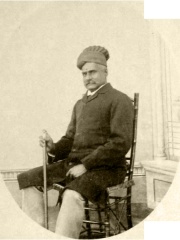
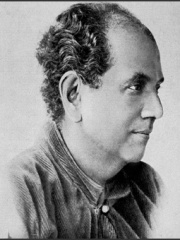
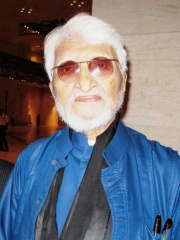
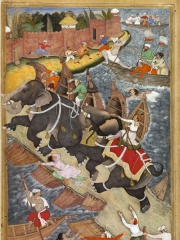
The Most Famous
PAINTERS from India
This page contains a list of the greatest Indian Painters. The pantheon dataset contains 2,023 Painters, 5 of which were born in India. This makes India the birth place of the 39th most number of Painters behind South Africa, and Latvia.
Top 5
The following people are considered by Pantheon to be the most legendary Indian Painters of all time. This list of famous Indian Painters is sorted by HPI (Historical Popularity Index), a metric that aggregates information on a biography's online popularity.

1. Raja Ravi Varma (1848 - 1906)
With an HPI of 75.10, Raja Ravi Varma is the most famous Indian Painter. His biography has been translated into 58 different languages on wikipedia.
Raja Ravi Varma (Malayalam: [rajaː ravi varma(ː)ɐ]) (29 April 1848 – 2 October 1906) was an Indian painter. His works are one of the best examples of the fusion of European academic art with a purely Indian sensibility and iconography. He greatly enhanced his reach and influence as a painter and public figure by making affordable lithographs of his paintings available to the public. His lithographs increased the involvement of common people with fine arts and defined artistic tastes. Furthermore, his religious depictions of Hindu deities and works from Indian epic poetry and Puranas have received critical acclaim. He was part of the royal family of Parappanad, Malappuram district. Raja Ravi Varma was closely related to the royal family of Travancore of present-day Kerala state in India. Later in his life, two of his granddaughters were adopted into the royal family.

2. Abanindranath Tagore (1871 - 1951)
With an HPI of 59.84, Abanindranath Tagore is the 2nd most famous Indian Painter. Her biography has been translated into 25 different languages.
Abanindranath Tagore (Bengali: অবনীন্দ্রনাথ ঠাকুর; 7 August 1871 – 5 December 1951) was an Indian painter who was the principal artist and creator of the Indian Society of Oriental Art in 1907. He was also the first major exponent of Swadeshi values in Indian art. He founded the influential Bengal school of art, which led to the development of modern Indian painting. He was also a noted writer, particularly for children. Popularly known as 'Aban Thakur', his books Rajkahini, Buro Angla, Nalak, and Khirer Putul were landmarks in Bengali language children's literature and art. Tagore sought to modernise Mughal and Rajput styles to counter the influence of Western models of art, as taught in art schools under the British Raj. Along with other artists from the Bengal school of art, Tagore advocated in favour of a nationalistic Indian art derived from Indian art history, drawing inspiration from the Ajanta Caves. Tagore's work was so successful that it was eventually accepted and promoted as a national Indian style within British art institutions.

3. M. F. Husain (1915 - 2011)
With an HPI of 57.56, M. F. Husain is the 3rd most famous Indian Painter. His biography has been translated into 41 different languages.
Maqbool Fida Husain (17 September 1915 – 9 June 2011) was an Indian painter and film director who painted narrative paintings in a modified Cubist style. He was one of the founding members of Bombay Progressive Artists' Group. M.F. Husain is associated with Indian modernism in the 1940s. His early association with the Bombay Progressive Artists' Group used modern technique, and was inspired by the "new" India after the partition of 1947. His narrative paintings, executed in a modified Cubist style, can be caustic and funny as well as serious and sombre. His themes—sometimes treated in series—included topics as diverse as Gandhi, Mother Teresa, the Ramayana, the Mahabharata, the British Raj, and motifs of Indian urban and rural life. In September 2020, his painting titled “Voices”, auctioned for a record $2.5 million. Husain's later works have stirred controversy, which included nude portrayals of Hindu deities, and a nude portrayal of Bharat Mata. Right-wing organisations called for his arrest, and several lawsuits were filed against him for hurting religious sentiments. He remained in a self imposed exile from 2006 until his death in 2011, accepting Qatari citizenship in 2010. In 1967, he received the National Film Award for Best Experimental Film for Through the Eyes of a Painter. In 2004, he directed Meenaxi: A Tale of Three Cities, a film he worked on with his artist son Owais Husain, which was screened in the Marché du film section of the 2004 Cannes Film Festival.

4. Basawan (1560 - 1600)
With an HPI of 56.52, Basawan is the 4th most famous Indian Painter. His biography has been translated into 18 different languages.
Basāwan, or Basāvan (flourished 1580–1600), was an Indian miniature painter in the Mughal style. He was known by his contemporaries as a skilled colorist and keen observer of human nature, and for his use of portraiture in the illustrations of Akbarnama, Mughal Emperor, Akbar's official Biography, which is seen as an innovation in Indian art.
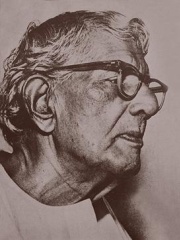
5. Jamini Roy (1887 - 1972)
With an HPI of 55.77, Jamini Roy is the 5th most famous Indian Painter. His biography has been translated into 20 different languages.
Jamini Roy (11 April 1887 – 24 April 1972) was an Indian painter. He was honoured by the Government of India the award of Padma Bhushan in 1954. He remains one of the most famous pupils of Abanindranath Tagore, another praised Indian artist and instructor. Roy's highly simplified, flattened-out style, and reminiscent of European modern art was influenced by the “bazaar” paintings sold at Indian temples as talismans.
People
Pantheon has 5 people classified as Indian painters born between 1560 and 1915. Of these 5, none of them are still alive today. The most famous deceased Indian painters include Raja Ravi Varma, Abanindranath Tagore, and M. F. Husain.
Deceased Indian Painters
Go to all RankingsRaja Ravi Varma
1848 - 1906
HPI: 75.10
Abanindranath Tagore
1871 - 1951
HPI: 59.84
M. F. Husain
1915 - 2011
HPI: 57.56
Basawan
1560 - 1600
HPI: 56.52
Jamini Roy
1887 - 1972
HPI: 55.77
Overlapping Lives
Which Painters were alive at the same time? This visualization shows the lifespans of the 4 most globally memorable Painters since 1700.

